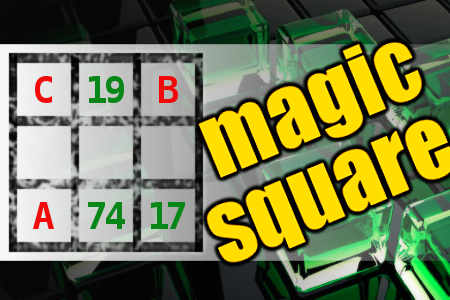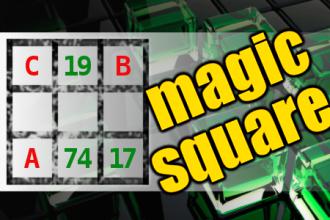MAGIC SQUARE: Calculate A-B-C
The aim is to place the some numbers from the list (2, 4, 6, 17, 19, 21, 47, 70, 72, 74, 88, 90) into the empty squares and squares marked with A, B an C. Sum of each row and column should be equal. All the numbers of the magic square must be different. Find values for A, B, and C. Solution is A-B-C.Correct answers: 12
The first user who solved this task is Nílton Corrêa De Sousa.
#brainteasers #math #magicsquare

On the first day God created t...
On the first day God created the cow. God said, "You must go to the field with the farmer all day long and suffer under the sun, have calves and give milk to support the farmer. I will give you a life span of sixty years."
The cow said, "That's a kind of a tough life you want me to live for sixty years. Let me have twenty years and I'll give back the other forty."
And God agreed.
On the second day, God created the dog. God said, "Sit all day by the door of your house and bark at anyone who comes in or walks past. I will give you a life span of twenty years." The dog said, "That's too long to be barking. Give me ten years and I'll give back the other ten."
So God agreed (*sigh*).
On the third day God created the monkey. God said, "Entertain people, do monkey tricks, make them laugh. I'll give you a twenty year life span." Monkey said, "How boring, monkey tricks for twenty years? I don't think so. Dog gave you back ten, so that's what I'll do too, okay?"
And God agreed again (...???...)
On the fourth day God created man. God said, "Eat, sleep, play, have sex, enjoy. Do nothing, just enjoy, enjoy. I'll give you twenty years."
Man said, "What? Only twenty years? No way, man. Tell you what, I'll take my twenty, and the forty cow gave back, and the ten dog gave back and the ten monkey gave back. That makes eighty, okay?"
"Okay," said God. "You've got a deal."
So, that is why for the first twenty years we eat, sleep, play, have sex, enjoy, and do nothing. For the next forty years we slave in the sun to support our family. For the next ten years we do monkey tricks to entertain our grandchildren; and for the last ten years we sit in front of the house and bark at everybody.
The cow said, "That's a kind of a tough life you want me to live for sixty years. Let me have twenty years and I'll give back the other forty."
And God agreed.
On the second day, God created the dog. God said, "Sit all day by the door of your house and bark at anyone who comes in or walks past. I will give you a life span of twenty years." The dog said, "That's too long to be barking. Give me ten years and I'll give back the other ten."
So God agreed (*sigh*).
On the third day God created the monkey. God said, "Entertain people, do monkey tricks, make them laugh. I'll give you a twenty year life span." Monkey said, "How boring, monkey tricks for twenty years? I don't think so. Dog gave you back ten, so that's what I'll do too, okay?"
And God agreed again (...???...)
On the fourth day God created man. God said, "Eat, sleep, play, have sex, enjoy. Do nothing, just enjoy, enjoy. I'll give you twenty years."
Man said, "What? Only twenty years? No way, man. Tell you what, I'll take my twenty, and the forty cow gave back, and the ten dog gave back and the ten monkey gave back. That makes eighty, okay?"
"Okay," said God. "You've got a deal."
So, that is why for the first twenty years we eat, sleep, play, have sex, enjoy, and do nothing. For the next forty years we slave in the sun to support our family. For the next ten years we do monkey tricks to entertain our grandchildren; and for the last ten years we sit in front of the house and bark at everybody.

